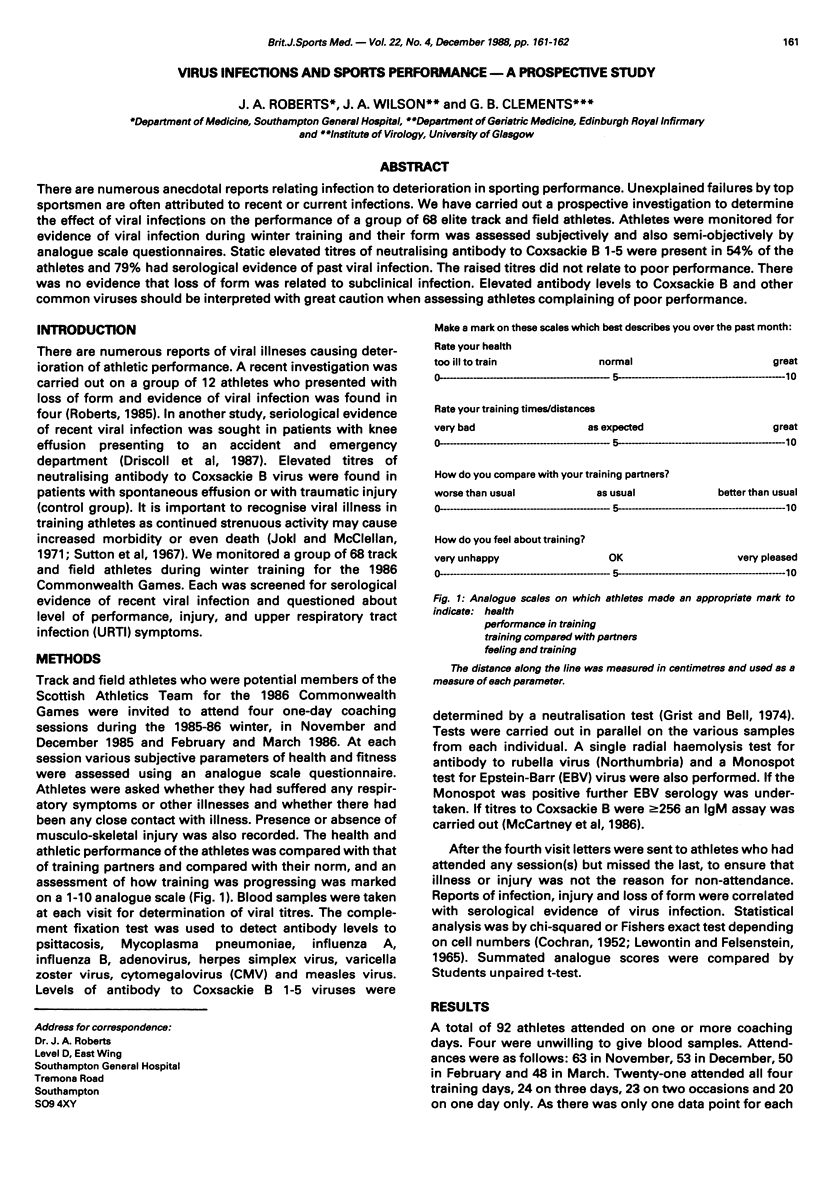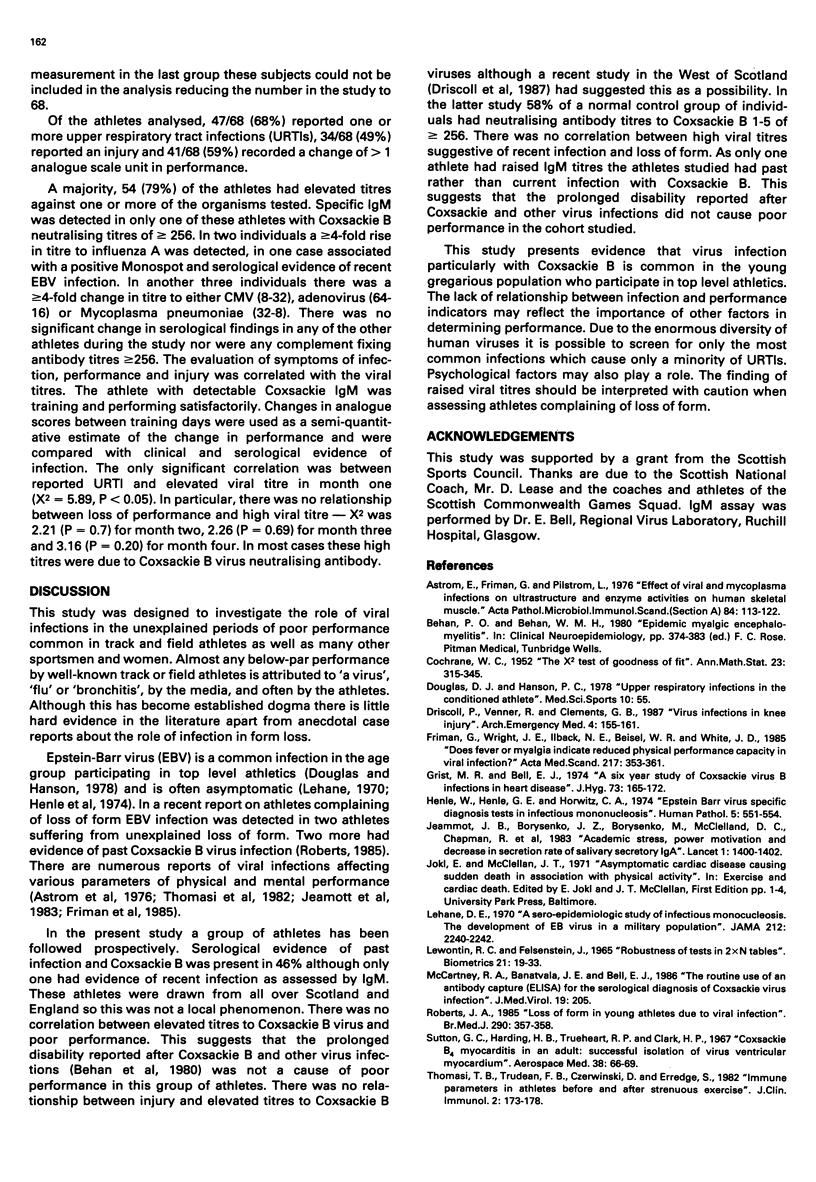Abstract
There are numerous anecdotal reports relating infection to deterioration in sporting performance. Unexplained failures by top sportsmen are often attributed to recent or current infections. We have carried out a prospective investigation to determine the effect of viral infections on the performance of a group of 68 elite track and field athletes. Athletes were monitored for evidence of viral infection during winter training and their form was assessed subjectively and also semi-objectively by analogue scale questionnaires. Static elevated titres of neutralising antibody to Coxsackie B 1-5 were present in 54% of the athletes and 79% had serological evidence of past viral infection. The raised titres did not relate to poor performance. There was no evidence that loss of form was related to subclinical infection. Elevated antibody levels to Coxsackie B and other common viruses should be interpreted with great caution when assessing athletes complaining of poor performance.
Full text
PDF

Selected References
These references are in PubMed. This may not be the complete list of references from this article.
- Aström E., Friman G., Pilström L. Effects of viral and mycoplasma infections on ultrastructure and enzyme activities in human skeletal muscle. Acta Pathol Microbiol Scand A. 1976 Mar;84(2):113–122. doi: 10.1111/j.1699-0463.1976.tb00080.x. [DOI] [PubMed] [Google Scholar]
- Driscoll P., Venner R., Clements G. B. Virus infection and knee injury. Arch Emerg Med. 1987 Sep;4(3):155–161. doi: 10.1136/emj.4.3.155. [DOI] [PMC free article] [PubMed] [Google Scholar]
- Friman G., Wright J. E., Ilbäck N. G., Beisel W. R., White J. D., Sharp D. S., Stephen E. L., Daniels W. L., Vogel J. A. Does fever or myalgia indicate reduced physical performance capacity in viral infections? Acta Med Scand. 1985;217(4):353–361. doi: 10.1111/j.0954-6820.1985.tb02709.x. [DOI] [PubMed] [Google Scholar]
- Grist N. R., Bell E. J. A six-year study of coxsackievirus B infections in heart disease. J Hyg (Lond) 1974 Oct;73(2):165–172. doi: 10.1017/s0022172400023998. [DOI] [PMC free article] [PubMed] [Google Scholar]
- Henle W., Henle G. E., Horwitz C. A. Epstein-Barr virus specific diagnostic tests in infectious mononucleosis. Hum Pathol. 1974 Sep;5(5):551–565. doi: 10.1016/s0046-8177(74)80006-7. [DOI] [PubMed] [Google Scholar]
- Jemmott J. B., 3rd, Borysenko J. Z., Borysenko M., McClelland D. C., Chapman R., Meyer D., Benson H. Academic stress, power motivation, and decrease in secretion rate of salivary secretory immunoglobulin A. Lancet. 1983 Jun 25;1(8339):1400–1402. doi: 10.1016/s0140-6736(83)92354-1. [DOI] [PubMed] [Google Scholar]
- Lehane D. E. A seroepidemiologic study of infectious mononucleosis. The development of EB virus antibody in a military population. JAMA. 1970 Jun 29;212(13):2240–2242. doi: 10.1001/jama.212.13.2240. [DOI] [PubMed] [Google Scholar]
- McCartney R. A., Banatvala J. E., Bell E. J. Routine use of mu-antibody-capture ELISA for the serological diagnosis of Coxsackie B virus infections. J Med Virol. 1986 Jul;19(3):205–212. doi: 10.1002/jmv.1890190302. [DOI] [PubMed] [Google Scholar]
- Roberts J. A. Loss of form in young athletes due to viral infection. Br Med J (Clin Res Ed) 1985 Feb 2;290(6465):357–358. doi: 10.1136/bmj.290.6465.357. [DOI] [PMC free article] [PubMed] [Google Scholar]
- Tomasi T. B., Trudeau F. B., Czerwinski D., Erredge S. Immune parameters in athletes before and after strenuous exercise. J Clin Immunol. 1982 Jul;2(3):173–178. doi: 10.1007/BF00915219. [DOI] [PubMed] [Google Scholar]


